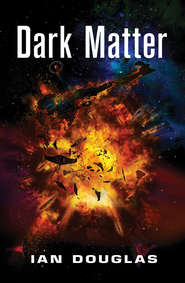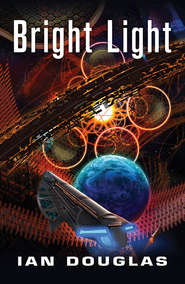По всем вопросам обращайтесь на: info@litportal.ru
(©) 2003-2024.
✖
Semper Human
Настройки чтения
Размер шрифта
Высота строк
Поля
“The quantum converters?” Schilling added. “The devices we use to provide microsuns for our terraform projects in the Kuiper Belt and beyond? We phase-shift those into the Quantum Sea, where they can draw as much energy as we need directly from the Reality base state. The Xul are doing something similar inside the Great Annihilator.”
“What?”
“We’re not sure,” Socrates said. “It’s possible that they hope to affect the entirety of the Reality base state … to, in effect, rewrite what we’re pleased to think of as reality.”
“Editing us out of existence?”
“It’s a possibility. That, at least, is one of the scenarios our Xul iteration programs have developed. But it’s also possible that they’re using singularity-identity nonlocality to infect our AI and computer networks with alien emomemes.”
“Whoa,” Garroway said. “You just lost me … about eight hundred years ago.”
“Singularity-identity nonlocality?” Schilling asked. Garroway nodded.
“The theory can be a bit murky,” Socrates told him. “Do you know how stargates work?”
“Not the technical details, but yes,” Garroway said. “In principle, at least.”
Stargates were immense artifacts scattered across the Galaxy and beyond, ten- to twenty-kilometer-wide rings within which pairs of planetary-mass black holes revolved in opposite directions. The interplay of moving gravitational fields opened direct links between one gate and another, light years distant, with which it was tuned. Exactly who had built them, or when, was a mystery, but stargates were still the principal means of long-range travel throughout the Galaxy.
“Stargates work,” Socrates told him, “because the movement of singularities within two stargates can be tuned to one another so that they essentially become congruent, a fancy way of saying they are the same. Identical. The same gate, but located in two widely separated places at once … orbiting Sirius, say, and the Galactic Core. The theory depends on quantum states and an aspect of quantum dynamics called nonlocality, which says that two objects or particles entangled at the quantum level remain connected to one another, as though there was no space, no distance, between them.”
“I know about that one,” Garroway said. “Albert Einstein called it ‘spooky action at a distance,’ and refused to accept that it described the universe realistically.”
“Albert … who?” Schilling asked.
“Einstein,” Socrates told her. “A pre-spaceflight philosopher.”
“Physicist, actually,” Garroway said. “At least according to the history downloads I’ve seen.”
“Physicist, then,” Socrates agreed, “though physicists and philosophers are much the same thing when it comes to describing aspects of the metaverse that can only indirectly be apprehended, and which can only be described by myth and metaphor. In any case … if you have access to base-state reality in one black hole, you theoretically have direct access to all black holes … and to the star gates as well, since they depend on artificial singularities for their operation.”
“We don’t know if they’re really trying to change reality,” Schilling said. “That may be too much of a stretch even for them. But we have detected signals emerging from several stargates that suggest they’re broadcasting emomemes.”
“And what the hell is an emomeme?”
“?‘Meme’ is an old term for a transmissible unit of cultural information,” Socrates told him. “Especially one that can be passed on from mind to mind verbally, by repeated actions, or through general cultural transmission. Religions are memes. So are fashions in bodily adornment. Or popular sayings or slogans or tunes or fads in entertainment or advertising.”
“Right,” Schilling said. “If I say ‘vavoob!’ That probably doesn’t mean much to you.”
“?‘Vavoob.’ Nope.” He shook his head. “Can’t say that it does.”
“But it’s a popular saying in Sol-System cities right now. It means … I don’t know. Sexy. Smart. Well integrated.”
“?‘With it?’?”
“With what?”
“Never mind. Your point is taken.”
“The expression is one of the current memes in human pan-urban culture,” Schilling told him. “Comes from a routine by Deidre Sallens, a well-known eroticomic VirSim personality. You haven’t been exposed, so it’s meaningless to you.”
“Memes tend to pass from person to person or group to group like a virus,” Socrates added.
“I’ve heard the term before,” Garroway said. “Even in my day. How is that different from an emomeme?”
“Emomemes are emotional memes … specifically those affecting how people feel about other people, about ideas or situations or groups. Things like racial stereotypes. Or prejudices against a given group of people or beings. A particular religion. A particular cultural worldview. A particular sexual practice or preference. They can also affect how strongly we respond to such impulses. Turning belief in a certain religious worldview into fanaticism, for instance. Or anger into rage.”
“And … you’re saying the Xul are beaming these things to us through the stargates?”
“There is intelligence to support this, General,” Socrates told him. “Yes.”
“How? I mean, how do these emomeme things affect humans? I always thought of ‘meme’ as a kind of metaphor, another word, maybe, for ‘idea.’ Not something with a physical reality.”
“In this case,” Socrates said, “they are quite objectively real.”
“Think of extremely efficient, self-contained, and well-camoflaged software,” Schilling told him, “viruses, if you will, infecting the personal AIs resident in people’s implants. Through the infected AIs, people’s attitudes, the strength of their emotional responses, even their very belief structures can be … changed.”
“Oh,” Garroway said. Then his eyes widened as the implications became clear. “Oh! …”
6
2201.2229
Associative AI Net Access
Government Node
Earthring, Sol System
2245 hours, GMT
“Gentlebeings, we have a problem. A big problem.”
Star Lord Garrick Rame looked out from his electronic viewpoint across the other representatives of the Associative Conclave. The stadium-sized chamber appeared to be filled with them, though only a handful were physically present. Most appeared within translucent pillars of light; some of them occupied luminous pillars that looked hazy or even murky with their native atmospheres. The Eulers, for instance, seemed to float within cylindrical columns of dark and nearly opaque water, while the one Veldik present was almost lost in the nearly impenetrable yellow mists of its sulfurous world. A few pillars were night black, their occupants nocturnal beings who shunned visible light.
“If you mean, Lord Rame, that the Xul group entity poses a threat to the Associative, the evidence suggests otherwise. We have no proof of these emomemonic manipulations you’ve described.”
The speaker was Lelan Valoc, a transfigured s-Human, her enlarged and elongated skull encased in the nano enhancement sheath hardwiring her into the Galactic Net. Her image addressed the Conclave from the speaker’s dais a few meters from Rame’s viewpoint.
In fact, each being linked into the Conclave saw the assembly from the same electronic viewpoint. The AI running the room simulation took care of projecting each image onto the speaker’s dais as that representative was recognized.
Overhead, within the vast dome of the room’s interior, a piercingly brilliant blue rose hung suspended in emptiness, backdrop to a multi-hued spiral disk of infalling starstuff. Rame had just completed his presentation, a virtual sim of the final moments of the OM-27 Eavesdropper Major Dion Williams, as it approached the Galactic Center. Together, the assembled Conclave had witnessed the doomed craft’s approach toward the Great Annihilator, had witnessed the eerie bending of light and beamed transmissions in a gravitational lensing effect, had watched the vessel shudder, flare, and disintegrate.
Вы ознакомились с фрагментом книги.
Приобретайте полный текст книги у нашего партнера:
Приобретайте полный текст книги у нашего партнера:











